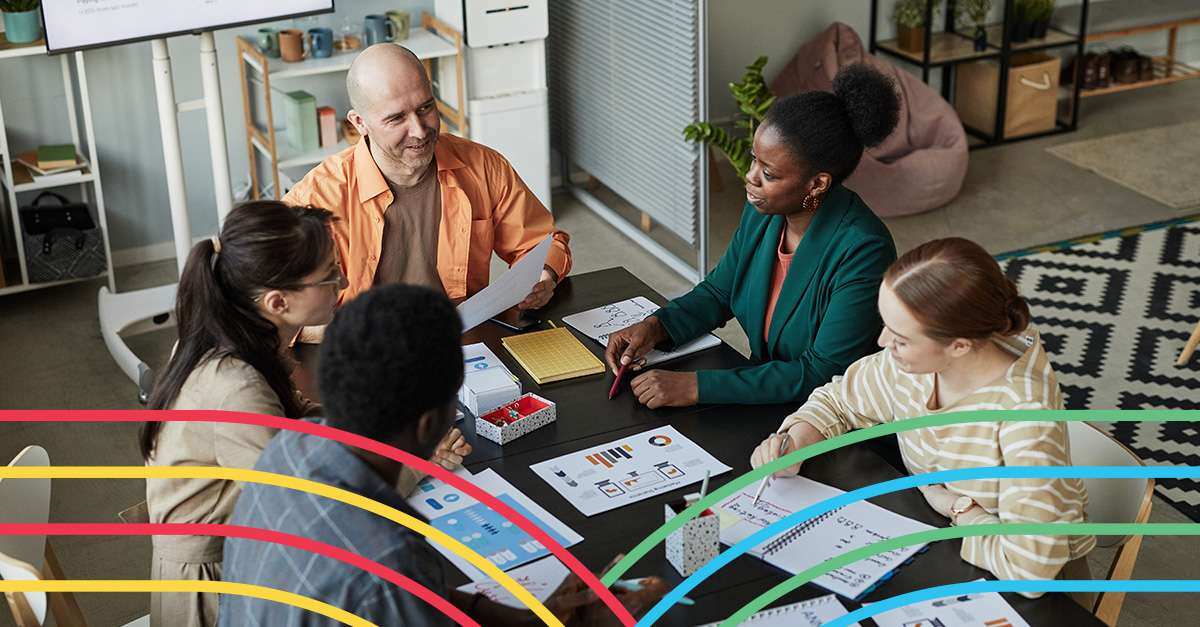Meetings can make or break your team productivity. They’re an invaluable forum for people to discuss important topics, share ideas, and collaborate on projects. But it’s easy for these gatherings to become stale and unproductive. If that sounds familiar, you need to explore new team meeting ideas.
Learn more about the importance of team meetings, how to refresh these gatherings, and how to incorporate Whole Brain® Thinking into meetings.
Why Team Meetings Are Important
Meetings are essential to any successful organization. They provide a platform for employees to come together, share ideas, and collaborate. They solidify relationships between co-workers and team leaders. With new teams or when introducing new people to an existing team, meetings help everyone get to know each other.
Meetings reflect your company culture, especially regarding whether people feel psychologically safe. Meetings also build culture, as leaders and employees reinforce norms and build rapport through open communication, strong listening, and collaboration.
Productive meetings are less about frequency or length and more about what happens during them. Is there a clear meeting agenda? Are meeting attendees allowed to present and brainstorm ideas without fear of judgment? Is everyone allowed to speak up in the best way for them? Do people know what they need to do after the meeting?
It’s easy to overlook that meetings are about people. As Mark Parnell of Atlassian writes, “But what is the purpose of most meetings if not to engage in close personal or emotional interaction, to attempt to better understand the progress and needs of our peers and what help they might need from us to reach their goals?”
Because meetings are about people, respect their time. Only bring them together to do meaningful work that requires a collective effort, especially when asking people to come in from home. When you’re picking topics for a team meeting, ask yourself, “Is this crucial work that helps us make better decisions, or is this a status update?” If it’s the latter, put it in an email.
While everyone wants meetings people won’t hate, you can do even more. When executed intentionally, team meetings are a powerful tool for improving team communication, collaboration, innovation, and outcomes.
6 Ideas to Refresh Your Meetings
If your meetings feel uninspired, stagnant, or unproductive, it’s time to make a change. Fortunately, there are endless possibilities for making a meeting more engaging. Consider the current state of your meetings, the makeup of your team, and what goals you’re trying to accomplish as you think about new ideas for meetings. Ultimately, you want to create gatherings that inspire workers, encourage cognitive diversity, and drive business results.
Here are six ideas for staff meetings that are more engaging and creative.
Incorporate Offbeat Meeting Activities
Instead of going to the conference room and sitting at the big table, shake things up with offbeat activities to engage your team’s imagination and bring out different perspectives. Consider scavenger hunts, online or in-person escape rooms, trivia, and other team-building activities.
For remote team meetings, consider ice-breakers such as “Two Truths and a Lie.” Such activities help your team, especially new employees, learn more about each other without making people feel singled out.
Hold Workshops
Sign up to our newsletter for the latest insights
When planning your workshop, start with a clear agenda so everyone understands what will happen and the expectations. Choose from various learning-oriented, engaging activities, such as brainstorming, group discussions, role-playing, and problem-solving.
During the workshop, reiterate the objectives and goals. Provide examples and case studies to illustrate the problem and bring the discussion to life. Encourage participants to drive the workshop to foster ownership and collaboration.
Finally, keep track of progress and document any decisions that were made. This will ensure that the workshop is productive and the team applies the lessons moving forward.
Inject Polls and Quizzes
Fun meeting ideas don’t have to lack substance. Polls and short quizzes can be great fun while helping team members engage with each other in a low-pressure environment.
Online polls solicit your team’s thoughts on particular topics before, during, or after meetings, depending on what you want to find out. Short quizzes can test your team’s knowledge without the pressure of a formal review. Both activities encourage communication and camaraderie as team members compare their responses or work together to find the answers.
For example, you start the meeting with a poll to gauge the team’s initial impression of a topic. Later in the meeting, after a fuller discussion of the topic, you can issue the quiz for team members to answer individually or in small groups — testing their knowledge and recall of what you’ve just talked about.
Break Into Smaller Groups
One way to re-engage your team in meetings is by starting with the entire group before breaking into small groups for discussion, brainstorming, or some other exercise.
For example, your team recognizes that customer service processes are inefficient, leading to longer response times and high costs. You break up the team into small groups of two to four people to brainstorm potential improvements. Each group is tasked with identifying and exploring one idea or solution that could improve your internal processes — and one action to take immediately after the meeting. After a reasonable period of discussion (10 or 15 minutes), the groups come back together and share their ideas and initial feedback from their peers.
Ask Someone Else to Lead the Meeting
Bringing in an outside guest speaker can introduce a different perspective to a stale topic or a thorny problem. Even if they can’t solve your team's challenge, they might help everyone see the situation differently.
Alternatively, look at the experts within your team and ask one of them to share their unique perspectives. This is where the cognitive diversity espoused by Whole Brain® Thinking can boost your meetings.
For example, your software development team is exploring new avenues for UX/UI design but is finding the status quo isn’t enough. If one of your team members is relatively new to UX/UI but has relevant experience in other industries, ask them to share how their background influences their current work. Sharing these unique perspectives with the rest of the team can inspire new ways of thinking, encourage collaboration, and solve the stagnation that the team is experiencing.
Change Locations
Sometimes, the simplest way to help your team think differently is to think in a different place. For in-person teams, reconsider where you meet. Instead of the same conference room you’ve booked for months, gather in a common area, get outside, or meet at a nearby lunch spot. This simple adjustment places the team in a new setting and stimulates creativity and engagement.
For virtual meetings, suggest that team members change their locations whenever possible. If that’s not possible, suggest a theme for the next meeting, or have everyone adopt a specific virtual background. The point is to encourage out-of-the-box meeting ideas that disrupt monotony.
.jpg?width=1200&height=627&name=Internal%20Image%20A%20-%206%20Ideas%20to%20Refresh%20Your%20Meetings%20(1).jpg)
Rethink Your Meetings Using Whole Brain® Thinking
Meetings bring together people who have at least one thing in common: They have a vested interest in the outcome of the meeting. But beyond that, they might have disparate goals, competencies, personal characteristics, thinking preferences, and lived experiences. Those differences aren’t a bad thing, but your meetings will be more successful when you recognize and incorporate such cognitive diversity.
Cognitive diversity is the collection of a group or organization's thinking styles, perspectives, and mindsets. One way to understand your team’s cognitive diversity is by applying the Whole Brain® Thinking framework and the Herrmann Brain Dominance Instrument (HBDI®) assessment.
Backed by over 40 years of experience, the Whole Brain® Thinking framework allows leaders to identify the cognitive diversity within their team and leverage it as a strategic advantage. Whole Brain® Thinking helps individuals, teams, and organizations understand their thinking preferences and that of their colleagues. With this knowledge, people can see how they process information, engage with ideas and other people. They can collaborate better by embracing these differences and building on each other’s unique preferences and abilities.
The Whole Brain® Thinking model groups people’s thinking preferences into four quadrants: Analytical (Blue), Structural (Green), Relational (Red), and Experimental (Yellow). These quadrants can also be called A (Blue), B (Green), C (Red), and D (Yellow). You can take the HBDI® assessment to understand your thinking preferences in the context of everyday situations and when you’re under pressure. Everybody uses all four thinking preferences daily, and there’s no correct or best combination of thinking preferences.
Incorporating Whole Brain® Thinking into your team meetings creates an intentional approach to understanding everyone’s distinct characteristics and how those differences can be a strength. Here are a few ways you can use Whole Brain® Thinking to rethink and refresh your meetings.
“Color” Your Meetings
Take a look at the Whole Brain® model for a snapshot of the four thinking quadrants. Is your team missing some key areas of thinking? Is there a specific area that needs more attention? Try injecting thinking-specific meetings into your lineup.
For example, if planning and details are a weakness, make it a point to organize a “Green” meeting, where the team focuses on Green/B-quadrant thinking aspects. Stuck in the weeds of a process-heavy project or task? Consider a “Yellow” meeting that encourages people to step outside the details and think in imaginative, big-picture, D-quadrant ways.
Encourage Reflective Discussion
Meetings work best when everyone feels they can participate through their feedback and ideas. Reflective discussion meetings bring this to the forefront through a meeting intended explicitly for team members to talk about a recent experience.
While reflection and self-awareness are always valuable qualities, this deliberate exercise allows your team to focus on a work theme or recent event, observe the experience, and move forward with better self-awareness and empathy for each other.
How does this work in practice with Whole Brain® Thinking? For example, a project team working on implementing an artificial intelligence (AI) tool for productivity might hold a reflection discussion after the initial rollout. Many analytical (Blue) and structural (Green) thinkers will likely be in the room, who were focused on the project's steps, projected outcomes, and initial data. They might find it helpful to reflect on how their work affected people (Red) and what type of productivity and innovation leaps the company can make because of this AI tool (Yellow).
On the other hand, managers or HR leaders who were part of the project might have experienced fears about how the workforce would be affected (Red), maybe even worrying about their jobs. They might reflect on how they raised their concerns while learning about the larger purpose (Yellow) and the dedication of the project managers rolling out the tool (Green). Reflective meetings aren’t the same as retrospectives, but they are both valuable for helping people look back at what they’ve worked on and how the team was affected.
Ensure Equal Participation By All Attendees
Meetings are easily dominated by the people who run the meeting, who are on the agenda to present, or who simply are the loudest and most outspoken. Team leaders, especially those elevating cognitive diversity, must consciously ensure that every team member is given a chance to contribute, whether by speaking up during the meeting, providing pre-meeting background information, or feeling comfortable offering feedback after the meeting.
The Whole Brain® Thinking framework helps leaders structure their meetings to allow for a broader range of input and ideas, even for more reserved team members.
For example, pair the quadrants of Whole Brain® Thinking with people’s job roles and responsibilities and then ask them to speak from that point of reference. For example, a team is meeting as they prepare a marketing campaign for a new consumer product. But two or three people seem to have thoughts but have yet to articulate them. Look at their job roles and how you might make time and space for their contributions.
For example, perhaps your product testing expert hasn’t contributed. You might note that the new consumer product needs to be 100% reliable so customers buy it and the company’s reputation grows. Draw in the testing expert by asking them to speak to this concern from the Red quadrant (the effect on people) and the Blue quadrant (what did the testing data say). This approach helps the team orient around a collaborative, diverse purpose without making anyone feel put on the spot.
.jpg?width=1200&height=627&name=InternalImageB_How%20Whole%20Brain%C2%AE%20Thinking%20Can%20Refresh%20Your%20Meetings%20%20(1).jpg)
Move Forward With Better Meetings
Meetings are an essential part of doing business, so it’s worth taking the time to get them right. New team meeting ideas are always needed to help your people work better together. Don’t be afraid to experiment. Not every meeting idea will help your team think better together. Keep at it till you find an approach that works.
By testing out meeting ideas and combining the above tips with the power of Whole Brain® Thinking, leaders will create energy and excitement around their meetings while grounding them in a culture of cognitive diversity, collaboration, and curiosity.
Download our free Meetings That Work Toolkit to learn more about running productive and engaging meetings.


.png?width=1200&name=Team%20Meetings%20-%20Featured%20(1).png)









